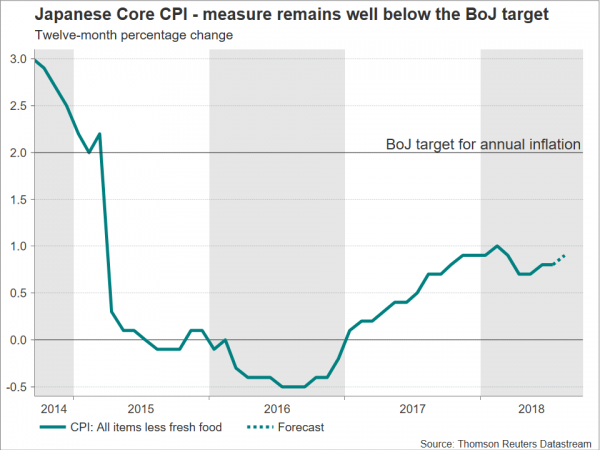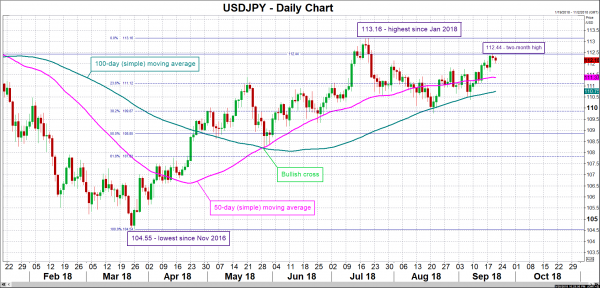Japanese inflation data for August will be hitting the markets on Thursday at 2330 GMT. The figures are expected to confirm that the Bank of Japan remains far off from achieving its inflation target and barring a significant deviation from analysts’ forecasts, they’re unlikely to spur considerable movements in yen pairs. What is instead likely to remain a primary driver of the currency’s direction are safe-haven flows – or the lack thereof – stemming from issues having to do with global trade.
The data released later in the day out of Japan are projected to show core CPI – this being the measure of inflation that excludes fresh food items but includes energy – growing by 0.9% y/y in August, above July’s 0.8% but still considerably below the BoJ’s target for inflation of 2% on an annual basis. The gauge has been rising since effectively the second half of 2016, eventually peaking at 1.0% in February of the current year, its highest since Q1 2015. This helped fuel growing speculation at the time that the Japanese central bank would soon enter into a path of policy normalization after years of ultra-loose monetary policies, and hence supported the yen. However, the reading has retreated in recent months, ranging between 0.7% and 0.9%. Its fall was accompanied with investors scaling back their bets for a more hawkish tilt by the BoJ, with dollar/yen advancing for the most part after touching its lowest since November 2016 of 104.55 in late March.
Elsewhere, headline inflation grew by 0.9% in July, also handily undershooting the central bank’s target; no August polls are available for this print, though it bears mention that the corresponding reading for the city of Tokyo that is considered a forward gauge of the nationwide number stood at 1.2%. Overall, the inflation landscape in Japan remains subdued, supporting the case for a BoJ that maintains its ultra-accommodative stance for the foreseeable future. Contrast this with the US central bank: next week the Federal Reserve is widely anticipated to deliver its eighth quarter percentage point rate increase since it begun normalizing rates in late 2015, while it is expected to signal that it remains firmly on policy-tightening mode. All these are pointing to further policy divergence between the US and Japan and thus higher yield differentials in the US’ favor, which are supportive of a stronger dollar/yen moving forward.
Beyond monetary policy, other factors are at play that can sway USDJPY in either direction. First on the list is trade uncertainty on the back of the confrontational rhetoric between the US and China that resulted in the two sides firing tariff shots at one another. Such uncertainty has in the past found the yen on the receiving end of safe-haven flows. To this end, investors seem to have largely set aside trade concerns in recent days, something which has allowed the greenback to track a two-month high of 112.44 versus the Japanese currency on Wednesday. Should the relationship between the world’s two largest economies significantly worsen though, then the yen is yet again likely to come under buying interest.
A rising dollar/yen on easing Sino-US trade tensions or sizably weaker inflation numbers relative to expectations, may meet immediate resistance around Wednesday’s two-month high of 112.44. Stronger advances will turn the attention to the zone around 113.16, the pair’s highest since the beginning of the year, recorded in late July. Conversely, market angst over an imminent deterioration in Chinese-American relationships or unexpectedly upbeat inflation prints, will likely lead to a falling USDJPY. The area between 111.37 and 110.75 captures the 50- and 100-day moving average lines, as well as the 23.6% Fibonacci retracement level of the upleg from 104.55 to 113.16 and may thus be of importance, providing support to losses in the pair. Further below, the region around the 38.2% Fibonacci mark at 109.87 would be eyed.
Remaining on trade, the US and Japan were planning their second round of trade talks during the current week. However, according to Japanese government sources, those will be delayed until after fresh tariffs imposed on China by the United States come into effect on September 24.
Lastly, September’s Nikkei manufacturing PMI will be made public on Friday at 0030 GMT (one hour after the numbers on inflation).















